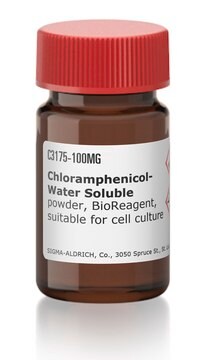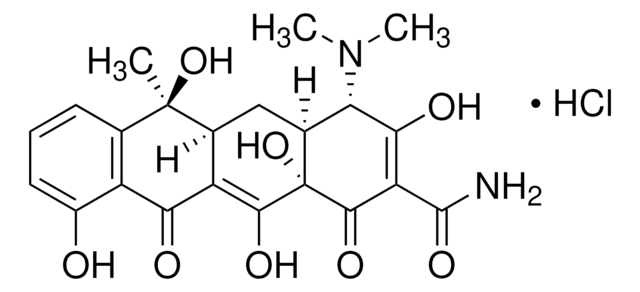R4408
Chloramphenicol
Ready Made Solution, 100 mg/mL in ethanol: isopropanol (95:5), ≥98% (HPLC)
Sinónimos:
D-(-)-threo-2,2-Dichloro-N-[β-hydroxy-α−(hydroxymethyl)-β-(4-nitrophenyl)ethyl]acetamide, D-(-)-threo-2-Dichloroacetamido-1-(4-nitrophenyl)-1,3-propanediol, D-threo-2,2-Dichloro-N-[β-hydroxy-α-(hydroxymethyl)-4-nitrophenethyl]acetamide
About This Item
Productos recomendados
Quality Level
assay
≥98% (HPLC)
form
solution
concentration
100 mg/mL in ethanol: isopropanol (95:5)
antibiotic activity spectrum
Gram-negative bacteria
Gram-positive bacteria
mode of action
protein synthesis | interferes
shipped in
dry ice
storage temp.
−20°C
¿Está buscando productos similares? Visita Guía de comparación de productos
Categorías relacionadas
Application
Biochem/physiol Actions
Mode of Resistance: Use of chloramphenicol acetyltransferase will acetylate the product and inactivate it.
Antimicrobial Spectrum: This is a broad spectrum antibiotic against gram-positive and gram-negative bacteria, and is used mainly for ophthalmic and veterinary purposes.
Packaging
Preparation Note
Other Notes
signalword
Danger
hcodes
Hazard Classifications
Carc. 2 - Eye Dam. 1 - Flam. Liq. 2 - Repr. 2
Storage Class
3 - Flammable liquids
wgk_germany
WGK 3
flash_point_f
57.2 °F - closed cup
flash_point_c
14.0 °C - closed cup
Elija entre una de las versiones más recientes:
¿Ya tiene este producto?
Encuentre la documentación para los productos que ha comprado recientemente en la Biblioteca de documentos.
Los clientes también vieron
Nuestro equipo de científicos tiene experiencia en todas las áreas de investigación: Ciencias de la vida, Ciencia de los materiales, Síntesis química, Cromatografía, Analítica y muchas otras.
Póngase en contacto con el Servicio técnico










